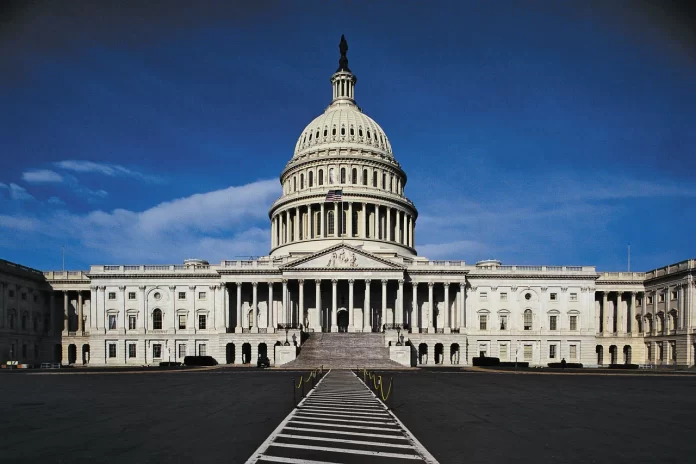118th CONGRESS
1st Session
H. J. RES. 18
To authorize the use of United States Armed Forces against those responsible for trafficking fentanyl or a fentanyl-related substance into the United States or carrying out other related activities that cause regional destabilization in the Western Hemisphere.
IN THE HOUSE OF REPRESENTATIVES
January 12, 2023
Mr. Crenshaw (for himself and Mr. Waltz) submitted the following joint resolution; which was referred to the Committee on Foreign Affairs
JOINT RESOLUTION
To authorize the use of United States Armed Forces against those responsible for trafficking fentanyl or a fentanyl-related substance into the United States or carrying out other related activities that cause regional destabilization in the Western Hemisphere.
Whereas armed cartels such as Sinaloa Cartel and the Jalisco New Generation Cartel are responsible for trafficking fentanyl and fentanyl-related substances into the United States;
Whereas fentanyl and fentanyl-related substances kill approximately 80,000 Americans every year and is the leading cause of death for American men between the ages of 18 and 45;
Whereas the Sinaloa Cartel and the Los Zetas Cartel, among others, consistently engage in violence against each other and other cartels, creating instability mere miles from the border of the United States;
Whereas in 2015, the Sinaloa Cartel shot down a Mexican military helicopter with a high powered weapon;
Whereas in 2019, when the Mexican National Guard arrested Ovidio Guzman, the son of Joaquin “el Chapo” Guzman, the Sinaloa Cartel attacked Mexican Government forces and forced them to release Ovidio Guzman;
Whereas in 2022, a battle between cartels along the United States-Mexico border led to the closure of two ports of entry;
Whereas in 2022, a grenade attack against the United States consulate in Nuevo Laredo, Mexico required employees to shelter in place;
Whereas Mexican cartels regularly intimidate, assault, kidnap, torture, and kill Mexican law enforcement; and
Whereas Mexican cartels have repeatedly fired at law enforcement and national guard posted along the United States-Mexico border: Now, therefore, be it
Resolved by the Senate and House of Representatives of the United States of America in Congress assembled,
SECTION 1. SHORT TITLE.
This joint resolution may be cited as the “Authorization for the Use of Military Force to Combat, Attack, Resist, Target, Eliminate, and Limit Influence Resolution” or the “AUMF CARTEL Influence Resolution”.
SEC. 2. AUTHORIZATION FOR USE OF UNITED STATES ARMED FORCES.
(a) In General.—The President is authorized to use all necessary and appropriate force against those foreign nations, foreign organizations, or foreign persons affiliated with foreign organizations that the President determines—
(1) have violated section 401(a)(1) of the Controlled Substances Act (21 U.S.C. 841(a)(1)), or have attempted or conspired to violate such section 401(a)(1) in violation of section 406 of such Act (21 U.S.C. 846), with respect to trafficking into the United States fentanyl or a fentanyl-related substance;
(2) have trafficked fentanyl or a fentanyl-related substance outside the United States with the intention of such fentanyl or fentanyl-related substance being trafficked into the United States in violation of section 401(a)(1) or 406 of the Controlled Substances Act (21 U.S.C. 841(a)(1), 846) as described in paragraph (1);
(3) have produced or trafficked a substance that is a precursor to fentanyl or a fentanyl-related substance with the intention of such precursor, fentanyl, or fentanyl-related substance being trafficked into the United States in violation of section 401(a)(1) or 406 of the Controlled Substances Act (21 U.S.C. 841(a)(1), 846) as described in paragraph (1);
(4) have engaged in kinetic actions against United States Federal, State, local, tribal, or territorial law enforcement personnel operating in the territory of the United States or abroad;
(5) have engaged in kinetic actions against law enforcement, military, or other governmental personnel of a country with a common border with the United States or any other country in the Western Hemisphere; or
(6) have used violence and intimidation for the purpose of establishing and controlling territory to be used for illicit means.
(b) Deemed Organizations.—Effective on the date of the enactment of this joint resolution, the following foreign organizations, and their members, shall be deemed to have been determined by the President under subsection (a) to meet the criteria described in such subsection:
(1) The Sinaloa Cartel.
(2) The Jalisco New Generation Cartel.
(3) The Gulf Cartel.
(4) The Los Zetas Cartel.
(5) The Northeast Cartel.
(6) The Juarez Cartel.
(7) The Tijuana Cartel.
(8) The Beltran-Levya Cartel.
(9) The La Familia Michoacana, also known as the Knight Templar Cartel.
(c) Limitation.—The authority to use all necessary and appropriate force pursuant to subsection (a) against foreign organizations and foreign persons affiliated with foreign organizations described in subsection (a) shall apply only with respect to those organizations and persons located outside of the territory of the United States.
(d) Termination.—The authority to use all necessary and appropriate force pursuant to subsection (a) shall terminate on the date that is 5 years after the date of the enactment of this joint resolution.
(e) War Powers Resolution Requirements.—
(1) SPECIFIC STATUTORY AUTHORIZATION.—Consistent with section 8(a)(1) of the War Powers Resolution, Congress declares that this section is intended to constitute specific statutory authorization within the meaning of section 5(b) of the War Powers Resolution.
(2) APPLICABILITY OF OTHER REQUIREMENTS.—Nothing in this joint resolution supersedes any requirement of the War Powers Resolution.
(f) Definition.—In this section, the term “fentanyl-related substance” means a fentanyl-related substance as described in section 1308.11(h)(30) of title 21, Code of Federal Regulations (or successor regulations).

